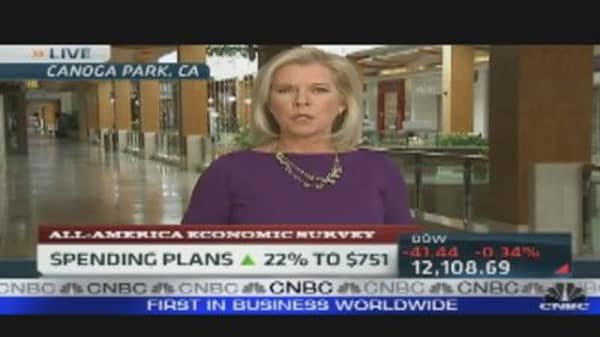Consumers plan to spend considerably more this holiday, but not in the same way they have in years past.
Where will Americans be shopping? The most popular destination remains big box stores, like Wal-Mart and Best Buy , where 42 percent of shoppers plan to do at least some spending, according to CNBC's All-America Economic Survey.
However, that's down six points from a year ago. Also down six points, the percentage of shoppers who plan to visit traditional department stores — 19 percent, versus 25 percent in 2010. At the same time, plans to shop online continue to move higher, with 27 percent of shoppers planning to buy online this year, up two points from a year ago.
The news comes as Walmart has been experimenting with two pop-up Walmart.com stores in Southern California since November first. One is in the Westfield Topanga mall in Los Angeles, next to Macy's . Wal-Mart says the small walk-in stores allow shoppers to pick up online orders, or they can get hands-on demonstrations with selected products like TVs and laptops and then order them online in the store. The two stores — the second one is in San Diego — are in areas with few Walmarts, and the company says it is getting "good customer feedback." However, there are no plans yet to roll out the concept on a wider scale.
The average U.S. shopper plans to spend $751 this year, a 22 percent increase from a 2010, according to this year's survey. The increases are strong in every income bracket. The biggest jump is at the high end, where holiday spending plans are up nearly 50 percent among those making at least $75,000, to $1,231. Yet even among the lowest income bracket, $30,000 or less, spending plans are up 28 percent, to $423.
Our survey also appears to provide further proof that consumer confidence is tied to home values. People who believe their homes will increase in value this year have more than doubled their holiday spending plans.
But they won't be taking out a second mortgage to pay for it.
This year, cash is king. Only one in five shoppers (21 percent) plans to use credit cards or other types of debt that will not be immediately paid off in full. The vast majority (74 percent) does not plan to carry the cost of holiday shopping into the new year, planning to use cash, debit cards, checks, or credit which will be paid off quickly. The strongest desire to avoid credit is among consumers living in the Midwest (81 percent), those ages 35-49 (78 percent), those with a high school or less education (82 percent), blue collar workers (83 percent), and African-Americans (79 percent).
For the first time, we asked shoppers more specifically about shopping on mobile devices. One in four (24 percent) say they've used a mobile device to do things like price compare items while shopping in a store. Sixteen percent say they've bought something on their smartphones and tablets beyond music, apps, and e-books. Not surprisingly, the strongest numbers here were in the 18-34 age group, where two out of five have used mobile devices in stores, and 27 percent have purchased goods and services on them.
Speaking of mobile devices, four out of five shoppers will not be buying — nor are they expecting to receive — Apple products this holiday. The group least likely to be giving or receiving an iPad, iPhone or iPod are the youngest shoppers, ages 18-34, perhaps due to the high price point.
As for Apple's future, the death of Steve Jobs hangs over the company like a cloud as it tries to move forward, but Apple should take heart in knowing most consumers aren't worried. More than half (53 percent) expect Apple to be as innovative as before, and 14 percent even think it will be even more innovative.





